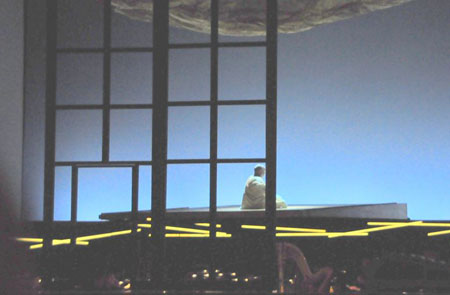
Before the opera begins, a solitary figure in white robes walks purposefully out on to stage from the right, turns onto a raised platform, and sits, facing slightly away from the audience.
This is how Wagner Dream, a modern British opera, begins. The opera is based in two worlds, that of 1883 Venice and the last day in the life of Richard Wagner, and 5th century India and the romantic entanglement of a young outcast woman and the Buddha’s cousin and chief attendant, Ānanda.
The divide in time is rather creatively visualized, allowing both to exist on stage simultaneously by placing the scenes from Venice on a narrow strip of stage in front of (from the perspective of the audience) the orchestra pit. The scenes from ancient India, meanwhile, take place on and around the platform behind the orchestra. The divide is further accentuated by the Welsh National Opera’s director Pierre Audi’s decision to have the sung dialogue of the Buddhists placed in Pali, which is commonly described as the language of the Buddha, but is actually a term meaning ‘text’ – referring to the recorded teachings of the Buddha and his disciples. Meanwhile the spoken dialogue of Wagner and friends is in German. Surtitles (supertitles) translate both above the stage in English and Welsh. The use of the two languages helps move the audience both out of their own world and into the lives of the characters on the stage.
As you would guess, this is a bit of a niche opera. Four languages, three time periods (if you include the very modern use of minimalist stage sets and electronic sound effects), and the clashing of two very distant cultures as a 19th century German composer encounters ancient Indian ideas and stories. Again we might add our own time period as a third culture, in some ways as distant from Wagner as he finds himself from the Buddha. And, to further complicate things, the story that was placed in Pali itself comes from Eugene Burnouf’s 1844 work, “Introduction à l’Histoire du Buddhisme Indien” (recently translated into English here), which is based on a Sanskrit text, the Divyāvadāna (Divine Stories) an anthology of Buddhist tales dating to around the 2nd Century CE.
– Full story : www.patheos.com
– By Justin Whitaker




